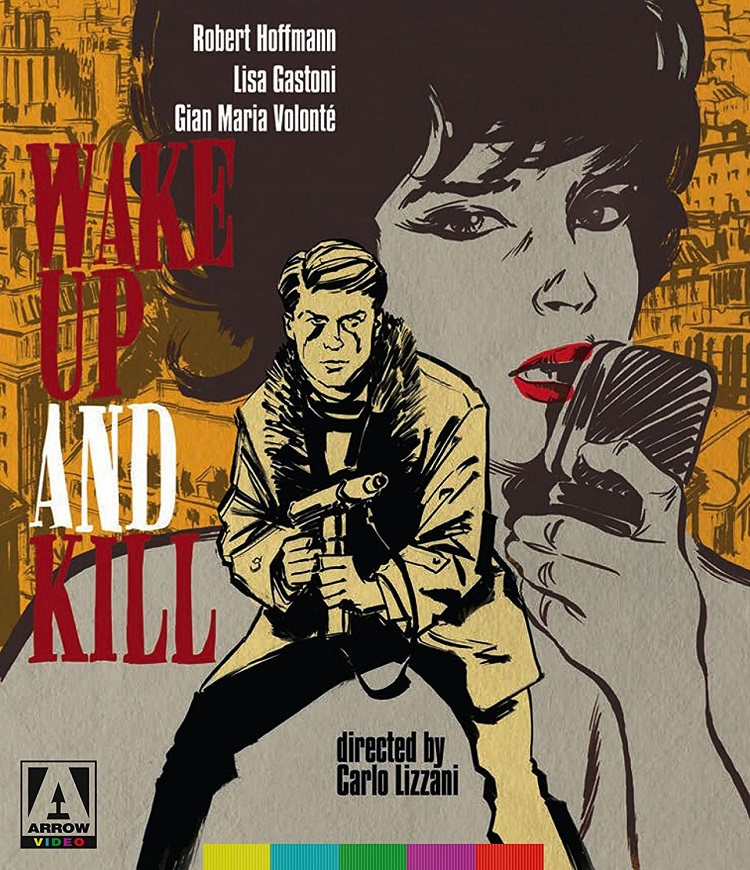
Wake Up and Kill isn’t quite a traditional gangster film. There’s a philosophy to the gangster film that requires a certain sort of specific ambition from its lead characters. The gangster in a movie commits crimes to get money to do something. To better his life, to provide for family or lovers or to be a part of a community. In Wake Up and Kill, Luciano Lutring’s criminality is never explained, or even deeply explored. He doesn’t seem to be very good at it – all his crimes, even as they become more elaborate and require greater planning, are basically smash and grabs.
He starts as a petty thief to be able to pay for a hotel room for a girl he’s lied to. Later, he tries to pin the theft on her ex-boyfriend who is also a criminal, which begins kind of a love triangle. The woman, Yvonne, hates Luciano’s criminal life, and constantly demands he promise to give it up. However, the second she gets in a fight with another woman (they were both up for the same nightclub gig – Yvonne is a singer) she threatens to sick her criminal boyfriend on the nightclub owner.
Robert Hoffman plays Luciano Lutring (a real life criminal and media sensation in Italy in the ’60s) as a man of wild gestures and mood swings. When he first tries to pick up Yvonne, she’s a chanteuse at a nightclub. She complains that he didn’t buy her a drink earlier, so he buys her 10. Minutes after robbing one jewelry store, he goes into another, and spends all the cash he has on an engagement ring for Yvonne, so she’ll have something relatively honest from him. He’s also terribly jealous of her, and smacks her around often enough that by the third such scene, I struggled to find some reason why I was supposed to be interested in this jerk.
The movie’s not necessarily all that interested in Lutring either, at least not as a person. A lot of the screen time is taken up with ancillary characters and adjuncts to his crime spree. The cops, other criminals, the press, all use the flamboyant Lutring in their own ways to further their own causes, and settle their own scores. He’s a patsy to everybody around him.
And a great deal of the film’s story is based around how everyone seemed to benefit from Lutring’s string of crimes except for Lutring himself. He steals a submachine gun that is almost immediately recovered by the police, but he hid it in a violin case, so the press dubs him the “Submachine Gun Soloist” despite the fact that he never had a chance to use the gun. It’s catchy, it will sell newspapers, and if it has only a tangential connection to the truth, so what?
At one point, Lutring plans a “last big score” type of crime, which takes months of logistics and several men to pull off. The men he brings in decide it’s a great idea, agree to go along, and the second he leaves the meeting decide how to set up Lutring to take the fall for the crime while they get away with the loot. That crime is one of several interesting action set pieces in a movie that, for the most part, involves a lot of shots of people talking. The crime scene is filmed in a raw, almost documentary style (director Carlo Lizzani was associated with Italian Neorealism, a film movement that deliberately moved away from Hollywood style cleanliness and cinematic perfection). Shots are intentionally roughly handled, focus isn’t always perfect, and traditional composition is loosened up. There are some bravura overhead shots while the criminals drive in, fire their submachine guns into the air, scattering crowds, and run into the jewelry store.
But the scene is a deliberate anti-climax, as nothing really gets resolved. Lutring shows up late to the crime (set up as a patsy) then he isn’t caught. The cops know full well that he didn’t commit the crime, but find it useful to pretend he did in order to not tip off the real criminals. The press is happy to go along with it because Lutring sells papers, which leads to a great, off-beat scene where Lutring sneaks into a newspaper, pointing his gun at people and accusing them of turning him with their stories into something he’s not.
The point of all of these separate storylines moving in and around Lutring’s crimes is to show how the forces of society can conspire, directly and indirectly, to damn the individual for things he couldn’t have done, because it is convenient or useful. It’s an interesting point… but an interesting point alone doesn’t make an interesting movie. And when the point of your story is that the main character isn’t worth the fuss built up around him that makes it more of an intellectual exercise than an enjoyable film. The tone of several scenes don’t fit together dramatically, for me – nearly every scene with Yvonne is played as high melodrama (or maybe Italian women are really just that excitable) while the cops and robbers stuff has that gritty, exciting documentary quality.
As is typical of Arrow Blu-rays, it all looks rather fantastic. It’s a very grainy transfer (keeping, I think, with the aesthetic of the film) and that nature of the filmmaking means it will not be a reference disc for anyone showing off their system, but it looks just like it’s supposed to. It’s 124 minutes long, 20 minutes longer than the running time listed on IMDB (which has it listed as Wake Up and Die, the American title. This version is included on the disc, and has English dialogue). Wake Up and Kill is a title just as sensationalistic as the newspapermen condemned in the movie – Lutring never kills anybody. Despite his infamy and audacity, he doesn’t really amount to much.